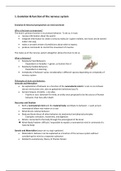1. Evolution & function of the nervous system
Evolution & historical perspectives on mind and brain
Why is the brain so important?
The brain’s primary function is to produce behavior. To do so, it must:
• receive information about the world;
• integrate information to create a sensory reality (er is geen realiteit, een hond ziet de wereld
anders dan wij);
• make a constant stream of predictions about what to expect;
• produce commands to control the movement of muscles.
The make up of the nervous system altogether allows the brain to do so.
What is Behavior?
• Relatively Fixed Behaviors
- Dependent on heredity -> genen, ze kunnen het al
• Relatively Flexible Behaviors
- Dependent on learning
• Complexity of behavior varies considerably in different species depending on complexity of
nervous system
Philosophy of brain and behavior:
Aristotle and Mentalism
• An explanation of behavior as a function of the nonmaterial mind Er is iets in ons lichaam
dat we niet kunnen zien, dat ons gedachten beïnvloed (soul?).
• Ancient Greece: Aristotle -> zijn idee
- Psyche or soul: Synonym for mind; an entity once proposed to be the source of human
behavior, that lives after death
Descartes and Dualism
• Both a nonmaterial mind and the material body contribute to behavior -> want je kunt
nonmaterial alleen niet meten en is raar
• Mind directs rational behavior
• Body and brain direct all other behavior via mechanical and physical principles
- Examples: sensation, movement, and digestion
• Mind is connected to the body through the pineal gland of the brain
➔ Mind–Body Problem: difficult / impossible to explain a nonmaterial mind in command of a
material body
Darwin and Materialism (waar we nu nog in geloven)
• Materialism: behavior can be explained as a function of the nervous system without
considering the mind as a separate substance
• Related to evolutionary theory of Charles Darwin
, Darwin’s Concept of Natural Selection:
• Differential success in the reproduction (i.e., passing on your genes) of different
characteristics / behavior (phenotypes) results from the interaction of organisms with their
environment!! -> als je beter met de omgeving om kan gaan, aan kan passen, heb je meer
kans om te overleven
• Traits / behavior that increase reproductive success and chances of survival will be passed
on to offspring
• Competition is a key concept
Evolution of animals having nervous systems:
➔ De mens begon ook als een simpel nervous system, elke species past zich weer op een
andere manier aan aan de omgeving, zo kon de brein ontwikkelen en zo werd het steeds
ingewikkelder. Er zijn karakteristieken uit de sea anamone die je nog steeds terug ziet in het
menselijk brein.
➔ Dit betekent dat het mensen meer complex gedrag kunnen laten zien
Neuroplasticity
• The brain is plastic:
- Neural tissue has the capacity to adapt to the world by changing how its functions are
organized
- Because the brain can adapt to the world, different species could develop
- Neuroplasticity is seen both in the developing brain and in adaptations of brain structure
following injury
➔ Je gedrag verandert ook je brein
Epigenetics (hoe het brein zich kan aanpassen aan de omgeving hangt hier vanaf)
• Study of differences in gene expression related to environment and experience (niet alle
genen hebben een invloed op je leven, komen tot uiting, dit is afhankelijk van de omgeving)
, • Epigenetic factors do not change your genes, but they do influence how your genes operate
• Epigenetic changes can persist throughout a lifetime, and the cumulative effects can make
dramatic differences in how your genes work and how likely a spieces is to pass on its genes
-> evolution
Plastic Patterns of Neural Organization: Phenotypic (= wat je in het echt kunt zien, gedrag?)
Plasticity
An individual’s genotype (genetic makeup) interacts with the environment to elicit a specific
phenotype from a large repertoire of possibilities!!
Twee muizen met exact dezelfde genen, de ene muis kreeg andere eten die
bepaalde genen activeerden
Studying Brain and Behavior in Modern Humans
The brain – and especially the cortex – is highly flexible
➔ That means that humans can live VERY different life styles in VERY different environments,
with equal skill and success. That also means that individual differences in brain organization
are huge! The average brain does not exist!
Anatomical & functional divisions of the nervous system
Central nervous system = brain and spinal cord
Somatic nervous system = information coming from your senses (muscles) to your brain and other
way around
Autonomic nervous system = heart rate, digestion
Enteric nervous system = what you eat, can effect your mood
Central nervous system
Overview of the structure of the brain:
• Forebrain: Major structure of the brain, consisting of two almost
identical hemispheres (left and right). Prominent in mammals and
birds, responsible for most higher order conscious behaviors.
• Cerebellum: “Little brain” - Involved in the coordination of motor
and cognitive processes. Forebrain
• Brainstem: Central structures of the brain, including the
hindbrain, midbrain, thalamus & hypothalamus. Source of behavior in simpler animals,
responsible for most of our unconscious behaviors. Spinal cord 16
• Spinal cord: Consists of nerves that carry incoming and outgoing messages between the
brain and the rest of the body including reflexes
, most complex
behavior
more easy behavior
(heartbeat for
example)
➔ Leren!!
Forebrain:
Cerebral / Neo cortex
The cerebral cortex is a thin sheet composed of 6 layers of nerve cells
folded many times to fit inside the skull responsible for regulating
various mental activities.
Allocortex Cortex
Evolutionary older part of cortex consisting of 3 or 4 layers of nerve
cells present in structures of the limbic system (cingulate cortex, hippocampus, amygdala), as well as
structures related to the olfactory system.
➔ Minder ingewikkeld
bijv. als je iets vergeten bent en ineens denk oeps!
-> leren!!





